Download instructions
Text version of the game:
If you wish to play khan games in a text console window, or are designing a khan game client yourself, you can download the command line engine (listed above). The documentation for the engine, and the game in general, follow:
Object of the game
In the era of the mongols (the 13th century AD), disparate tribes were
constantly at war with one other.
Khan is a chess-like board game (uci
compliant), with an original twist on warriors from the Ghengis Khan
era.
The goal of the game is to capture the leaders
of an enemy tribe and assimilate them before the enemy tribe assimilates
you.
Board setup and piece movements
To play the command line engine version of the game, download the executable
(mac or windows), save it in a folder, then run it.
You will get the following board display:
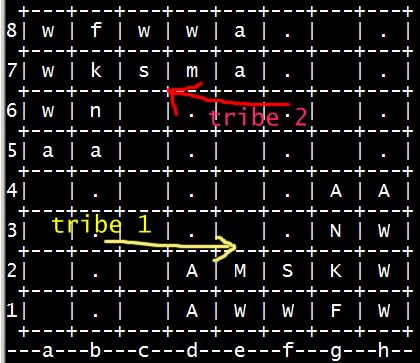
Two tribes occupy either side of the board. White pieces denote one tribe and are depicted in upper case (K A S N M W F). Black pieces denote the opposing tribe, that are depicted in lower case (k a s n m w f).
The pieces, in increasing order of rank, are:
(S) SWORDSMAN, moves 1 square on diagonals.
(N) ASSASIN, moves up to two squares on the horizontal and vertical.
(A) ARCHER, moves 1 square in any direction.
(M) MAGICIAN, moves 1 square on horizontal and vertical. Can cast spells
on enemy pieces up to 2 squares, demoting them to lower-ranking pieces.
(W) WARRIOR (mounted bowman), moves 2 squares in any direction.
(F) BONDSMAN: mounted bowman having all the movements of the WARRIOR
with extended 3 square range on the horizontal and vertical. This is
the khan's right hand man (the first bondsman), and is the backup leader
of the tribe.
(K) KHAN, is the main leader of the tribe. He moves like a WARRIOR with
an extended 3 square range on the horizontal, vertical and diagonal.
To win, you must capture both the enemy Khan (k) and the Bondsman (f).
Here are some examples of the piece movements (taken from the basic game configuration, with no magicians):
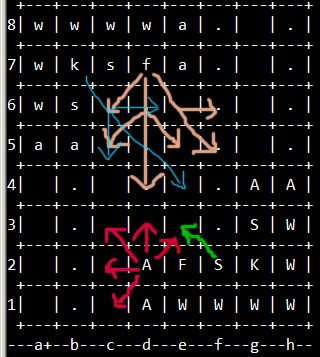
In the above diagram,
The white archer at square D2, can move to 5 positions (see red arrows).
The piece is blocked in the other directions by the white first bondsman
'F' at square E2 and the white archer 'A' at square D1.
The white swordsman at F2 can move to only square (see green).
The black bondsman at D7 can move to any # of squares (see rose).
The black khan at B7 can move to 5 possible squares (see blue arrows).
The other squares like B5 and B6 are blocked by surrounding pieces.
None of the warrior (W) pieces of either side can move because they
are blocked. (Note: pieces cannot move off the board)
Move summary:
If a piece is at position x, below, here are the potential range of moves in the basic configuration:
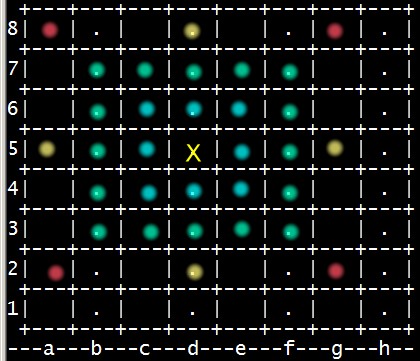
where 'x' is:
Archer(A): [can move to blue squares]
Warrior (W): [can move to blue and green squares]
Bondsman(F): [blue + green + yellow]
Khan (K): [blue + green + yellow + red]
Magicians:
In a more advanced startup game configuration, we have magicians, pieces which can move as follows:
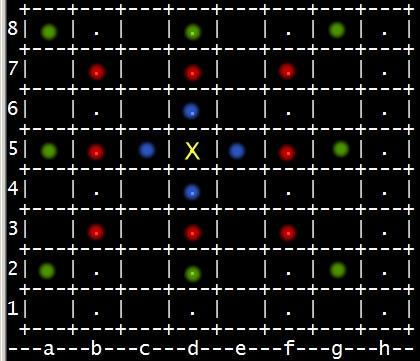
If a magician (M) is at square 'x', then he can physically move to any of the BLUE squares, provided they are UNOCCUPIED, or, he can cast spells on enemies residing on any of the blue OR red squares. After casting his spell he does not move from his position at 'X'.
Note: Magicians cannot capture enemy pieces. They can only 'demote' them to the next lower rank.
For example, if an enemy Archer is at square B7, then the magician at x can demote him to rank 'S' (SWORDSMAN).
This is equivalent to the magician fouling the archer's bow, or leaving the Archer with only a sword to fight with.
Likewise, if an enemy Warrior (F, W or K) is at square D3, then the magician can demote him to rank 'A', or ARCHER.
This is equivalent to the magician fouling the warrior's horse, or leaving the Warrior stranded with only a bow to fight with.
Magician spells can be extended to the green squares by typing:
rules magicianextendeddemotionsqs 1
and another tier of squares beyond that by typing:
rules magicianextendeddemotionsqs 2
Similarly, for powermagicians (M+):
rules powermagicianextendeddemotionsqs [1/2]
Power magicians:
Power magicians are magicians that have extended mobility. Think of them like magicians, but on a horse, so they can move like a warrior, but still retain all the spell-casting abilities with range.
You can start a game of power magicians by typing:
new powermagician
A synopsis of piece movements
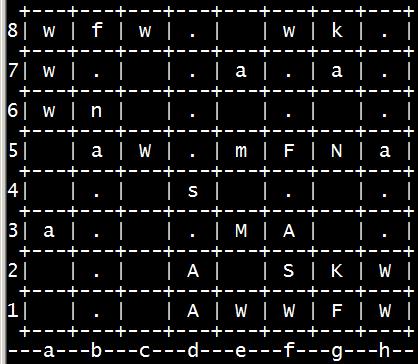
In the above board setup, the archer at B5 can capture the white warrior at C5.
Likewise, the warrior at C5 can capture the archer, depending on whose turn it is to move.
The white warrior cannot capture the black warrior at A6, because its path is blocked by the pieces at B5 and B6.
Likewise, the black warrior at A6 cannot capture the white warrior at C5 for the same reasons.
The same white warrior can capture the black magician at E5. The magician cannot capture the white warrior because of his innate rule of not being able to kill enemies, but he can demote the warrior to next lower rank (an Archer), depending on whose turn it is to move.
The magician can also demote the assassin at G5 to a swordsman, casting his xray spell through (F), the bondsman.
The magician can also demote the white enemy magician at E3 to a lower ranking one (M-) that can only move one square on the horizontal and vertical, thus severely limiting his spell-casting ability. If it were white's turn to move, the magician at E3 could similarly cast a spell on E5 and demote him to a lower ranking piece.
The Assassin at G5 (which has 2 squares mobility in horizontal or vertical directions) cannot capture the magician at E5 because it is blocked by F5 by F.
He can capture the archer at H5 and G7 though. He cannot attack the white Khan at G2 because the Khan is outside his range, but the Khan at G2 can capture him because he is within his attack range (3 squares on the horizontal, vertical or diagonal).
The First bondsman at F5 can capture the black warrior at F8 because he has 3 square range on the horizontal and vertical.
But the black warrior cannot capture F, which is out of range as warriors have only a 2 square mobility.
The black swordsman at D4 can capture the magician at E3, but he cannot capture mounted pieces like W at C5.
This is because a swordsman could never kill a mounted bowman in real life. He would get ridden down or bowed down in short order.
Note: this rule can be changed, allowing swordsmen to capture mounted pieces. Type:
rules swordscapturemounts
The game capturing logic proceeds like regular chess would: any piece can take any other piece (except magician).
Making moves
To make a move, type
m f2e3 [hit enter]
This will move your WHITE swordsman at F2 towards the centre of the board at E3:
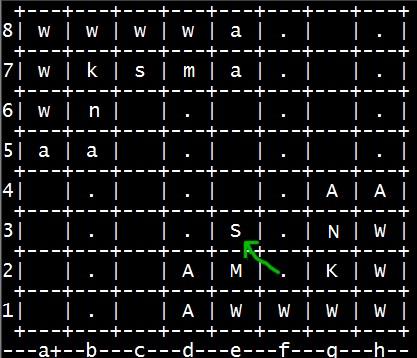
If you made a mistake, then type undo. This restores the board.
(You can type redo to replay the move.)
Once you have made a move, you prompt the computer to make a move by typing:
g [enter]
You see:
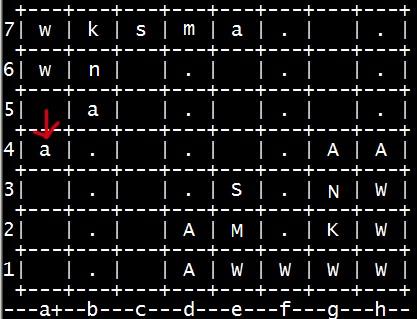
That black moved his archer from A5 to A4.
(Note: the first few opening moves are randomized, so you may see a different move other than this.)
Khan under threat
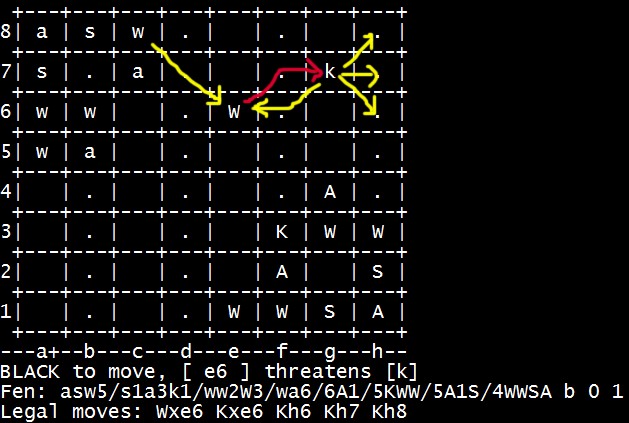
In the above diagram, WHITE has moved his warrior to E6 to attack the BLACK khan at G7 (see red arrow threat).
The yellow arrows show the options for black who must move out of the threat.
Options: Black's khan can move to any of the 3 squares (H6,H7,H8) denoted in yellow, or black can capture the offending piece (k at G7 takes W at E6) or (w at C8 takes W at E6). These moves are denoted as [kxe6] or [wxe6] as listed in the legal moves below the board. The black khan cannot move to any other squares because it will be threatened by the white warrior at E6 or the white archer at G4. If the black khan tries to take the white archer at G4, it will get killed by K at F3, W at G3 or W at H3.
How to win
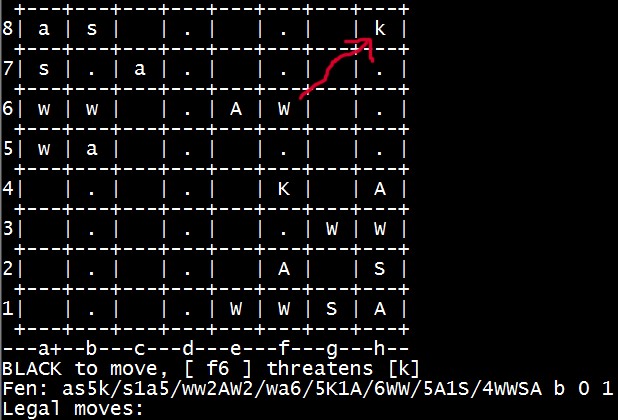
In the above diagram the white warrior has moved to F6 and the black khan has no more moves and no backup leader (f) and is under threat by the WHITE warrior at F6 (see red arrow).
The game is over, white wins.
(Note: Black's escape routes are all defended by W at F6 and K at F4. If the black khan tries to take the white warrior at F6, it will get taken by the white archer at E6.)
Types of games
There are 3 core types of games: 'basic','magician' or 'powermagician'
The default game is 'magician', where each side has a magician positioned on the 2nd rank. The 'basic' game is one without magicians, which involves somewhat easier play...
A more advanced game is available by selecting 'powermagician'. Each side has a magician (M+), with extended mobility. The power magician has all the power of the regular magician (M), but can move like a Warrior in a 2 square range...of course, provided he doesn't demote anything while moving.
To select this game, type:
new powermagician
In addition, there are 7 game rules, which function as options in conjunction with the above 3 games. This allows custom play:
Type 'rules' to see the current game rules:
Current game rules:
===================
bondsmen leaders are: ON ..[bondsmenleaders/nobondsmenleaders]
Enemy base promotions are: ON ..[basepromotions/nobasepromotions]
capturepromotions are: OFF ..[capturepromotions/nocapturepromotions]
Exchanges moves are: ON ..[exchanges/noexchanges]
Swords capture mounts is: OFF ..[swordscapturemounts/noswordscapturemounts]
Magician demotes Khan is: ON ..[magiciandemoteskhan/nomagiciandemoteskhan]
# Magician extended demotions squares is: 0 ..[magicianextendeddemotionsqs 0-2]
# Power magician extended demotions squares is: 0 ..[powermagicianextendeddemotionsqs 0-2]
You can turn on or off any of these options by typing:
rules nocapturepromotions/capturepromotions swordscancapturemounts/noswordscancapturemounts magiciandemoteskhan/nomagiciandemoteskhan ... or any of the keywords that are listed
For example, entering the command:
rules nobondsmenleaders
turns off multiple leader play, then a player must only capture the enemy Khan (K) to win the game.
Promotions, an advanced game feature, are described in the following section.
Swordscapturemounts is described in a prior section ('A synopsis of piece movements').
Exchange moves are described in a following section.
Magiciandemoteskhan is described in the 'Demotions' section following.
Setting # of magician/power magician extended squares to anything other than zero, extends the spell-casting range of a Magician or Power magician.
Ex:
rules powermagicianextendeddemotionsqs 2
grants the powermagician (M+) an extra 2 squares of spell-range casting, making him a devastating opponent...
Type 'game' to see the current game configuration: ('basic','magician','powermagician')
Promotions
There are 2 types of promotions in khan, 'enemy base promotions' and 'capture promotions'.
Enemy Base promotions
Throughout history, the mongols were always worried about having their base camp discovered and pillaged by enemies.
For this reason, they would always leave behind a small force to guard the camp, usually injured or older warriors and of course, their women and children.
If a player manages to get a minor piece to the enemy camp (any of the 4 corner squares in enemy territory), then that piece is automatically promoted to 'Warrior' status. Basically the piece gains a horse and/or weapons necessary to elevate the piece to that rank. In real life, note the mongols would always leave behind extra horses and weapons, the former being their life blood. By default, enemy base promotions are turned on. To disable the option, enter:
rules nobasepromotions
The enemy bases are as follows:
squares B7 B8 A7 A8 (for white)
squares G1 G2 H1 H2 (for black)
Breakdown:
Upon reaching the enemy base, the Magician (M) can be promoted to a Power magician (M+)
Archers (A), Swordsmen (S) and Assassins (N) can be promoted to Warrior (W)
Khan archer (K-) can be promoted to Khan (K)
Khan sword (K--) can be promoted to Khan (K)
Note: Warriors and Bondsmen cannot be promoted, because they already have weapons and horse...
Capture promotions
In real battles, a fighter will make use of any enemy's resources the moment he defeats him.
For this reason if a Swordsman captures an Archer, he would get his bow and become a bowman.
Likewise, if a swordsman or Archer captures a Warrior, then that fighter would lay claim to his horse and become a mounted warrior.
Here are the logical combinations of promotions that occur after captures are made:
| Fighting piece | Captures | Promotes himself to |
| Sword | Archer | Archer |
| Sword | Warrior: (W/F/K) | Warrior |
| Assassin | Warrior: (W/F/K) | Warrior |
| Archer | Warrior: (W/F/K) | Warrior |
Demotions
Likewise, demotions operate on the same principle, but in reverse order, and are governed by magicians casting spells on enemy pieces:
| Fighting piece | Casts spell on | Demotes piece to |
| Magician (M/M-/M+) | Magician (M) | Lower order Magician (M-) |
| Magician (M/M-/M+) | Warrior: (W/F) | Archer (A) |
| Magician (M/M-/M+) | Khan (K) | *Horseless Khan(K-) |
| Magician (M/M-/M+) | Horseless Khan: (K-) | *Swordsman Khan(-K-) |
*Provided the magiciandemoteskhan rule is set to on in rules section (the default is on).
These rules make for more complex game analysis on part of the player, but are more challenging to play. In particular, PROMOTIONS logic discourages undefended attacks by higher order pieces(like W). Unsound trades (WxW) result in devasting losses of material, when lower order pieces like the archer promote themselves on the trade.
By default, PROMOTIONS are turned OFF and DEMOTIONS are in effect as long as there are magician(s) on the board...
To clear the board of magicians, select the 'basic' game configuration by typing:
new basic
Exchanges
If the Khan gets demoted by an enemy magician to a Khan archer (K-) or Khan sword (-K-) piece, then that piece has the option of promoting himself back to a Khan of higher rank by exchanging with an adjacent Warrior (W/F) or Archer (A) piece respectively.
Of course, the Warrior or Archer gets demoted, and such is the price for the exchange.
In long range strategy, it is almost always advantageous to promote the Khan back to its highest value rank, which reduces the chance of an easy capture by the enemy. You lose a warrior type piece, albeit, which may be crucial in offense or defense, so there is a tradeoff.
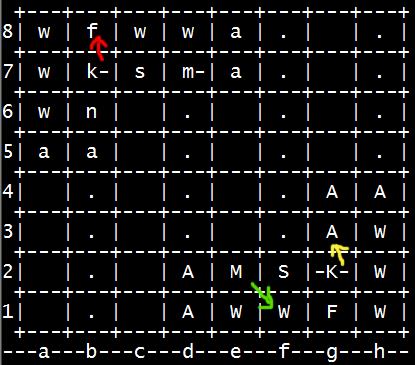
Black, above, can exchange its Bondsman on B8 (see red arrow), or any of the 3 surrounding warriors to 'give a horse' to its khan to get him up to full strength again. The Warrior/Bondsman piece is demoted the Warrior to an Archer.
Black types m b7b8 to accomplish this. Note that the bondsman is not the best piece to exchange with k- because it has highest value and will be demoted to an Archer, but there will be times when it may be the only choice and the difference between losing the game and drawing, or even winning.
In parallel, white could promote its magician on E2 to a power magician (see green arrow) by employing a similar trick. White moves m e2f1.
Now the power magician has the mobility of a mounted warrior while the 'exchanged' warrior at F1 has been reduced to an Archer.
On the next move, white could exchange its doubly demoted, sword-like Khan (-K-) on G2 for a K- (archer-like khan) with archer mobility (m b7b8) (see yellow arrow)
Only one Archer is within 1 square of the khan so there is only this possibity of exchange.
As an aside: the demoted magician (m-) at D7 cannot be promoted to anything greater. Its rank is fixed at this point, and is equivalent roughly to a Sword.
If all 3 of the above described moves are made, the board looks like:
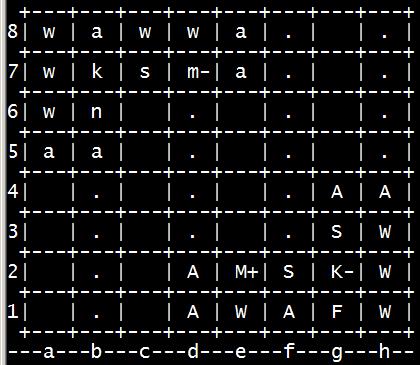
Exchange combinations
Here is a tally of the logical combinations of exchanges that can occur for both the Khan and Magician:
| Fighting piece | Exchanges with | Promotes himself to | Demotes the exchange piece to |
| Khan archer (K-) | Warrior: (W/F) | Khan (K) | Archer |
| Khan sword (-K-) | Archer | Khan archer (K-) | Sword |
| Magician (M) | Warrior: (W/F) | Power magician (M+) | Archer |
To turn off these capabilities in the game, select:
rules noexchanges
to turn off exchange moves. By default, Exchange moves are on.
I'm stuck, I don't know where to move
You can ask the computer to give you a hint by typing:
h [enter]
You see:
Hint >d2d3
The computer then is suggesting to move your WHITE archer from D2 to D3.
Saving and opening games
Type 'save mygame.txt' to save the current game to the current folder.
You can resume your game at a later time by typing:
open mygame.txt
If the program is installed in C:\Khan, for example, then all files will be stored here. You can replay a game's moves by typing undo ('u') or redo ('r') or 'start' (to move to the first move in the game) or 'start x' (to move to a particular move).
Note: a backup file of the current game is stored in backup.txt in the current directory after every move, so you can always restore to the last game saved by typing:
open backup.txt
Replaying moves
Once moves have been made, or a game has been loaded, you can page to any board position of any move. Type:
start (moves to the initial board position)
redo (replays the 1st move)
redo (replays the 2nd move)
undo (goes back to the 1st move)
end (moves to the last move)
start 3 (moves to the 3rd move board position)
showmoves (shows all the moves made so far)
The game is too hard or too easy
To make Khan play stronger, increase the move time. Type 'g 8'. This will allow the computer to move in 8 seconds versus the default search of 3 seconds. Higher search depth makes it harder to beat when deeper tactics are explored. (A 3s search time is enough to challenge most casual players.)
You can also set the default move time by typing:
mt 8
Then when you type 'g', the computer moves in 8 seconds.
To make Khan play easier, you can select a particular skill level. Enter:
skill 1 [very easy]
skill 2 [ a little less easier]
skill 3 [ even less easier]
... up to
skill 12 [harder], etc
A skill level specification of x, searches for moves up to depth x, where x is one "half" move, WHITE or BLACK.
If skill level is set to 4, the computer is searching 2 of its (black) moves and 2 of its (white) opponent moves ahead... Strongest play is still assured by setting the time control to an absolute setting, ie 'mt x' or 'g x'. For example,
g 10
Tells the computer to search at maximum depth up to 10 seconds. On a fast machine, this will be searching at least 6 full moves ahead (12 plies), white or black.
Playing computer against computer
Typing g [Enter]
when it is black or white's turn to move, will allow the computer to play the roles of both black and white.
You can then watch the computer's style of play while learning the piece movements.
Additionally, you can set specific move time or skill levels for black or white via the 'mtb' (movetime black) or 'skillb' (skill level black) commands:
mtb 2 (sets movetime for black to 2s)
mt 6 (sets movetime for white to 6s)
cc (signals computer on computer mode)
or
skillb 2 (sets skill level for black)
skill 4 (sets skill level for white)
cc
You can mix and match:
mt 3 (sets movetime for black to 2s)
skill 5 (sets skill level for white)
cc
Type 'cc off' to turn off the computer versus computer mode (saves memory).
Note: cc forces each side to search for moves in their own private memory space.
This avoids one side capitalizing on the work done by the other.
Changing console window size, color, etc (Windows)
The default console window size is generally too small to play the game comfortably. The board keeps scrolling off the screen. You can maximize the window by clicking the middle square on the top right of the window, or you can increase the window height by right mouse clicking on the window title bar and selecting "Defaults". You get:
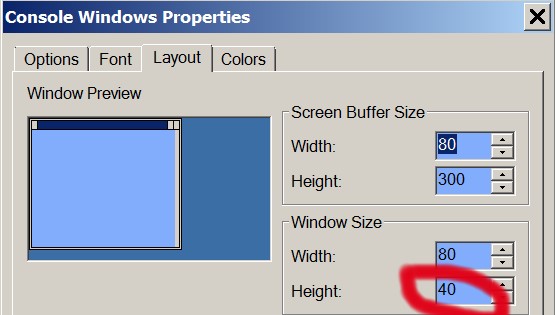
Select the Layout tab and change height to 40:
You can optionally change the foreground/background color settings for something softer to the eye. I like the blue background (red:130, green:163, blue:253), with the "Screen text" color set to black:
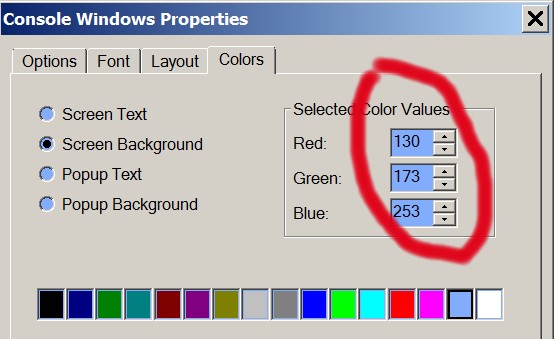
Other functions, setting up board positions, new game, etc
Type ? to see a list of commands:
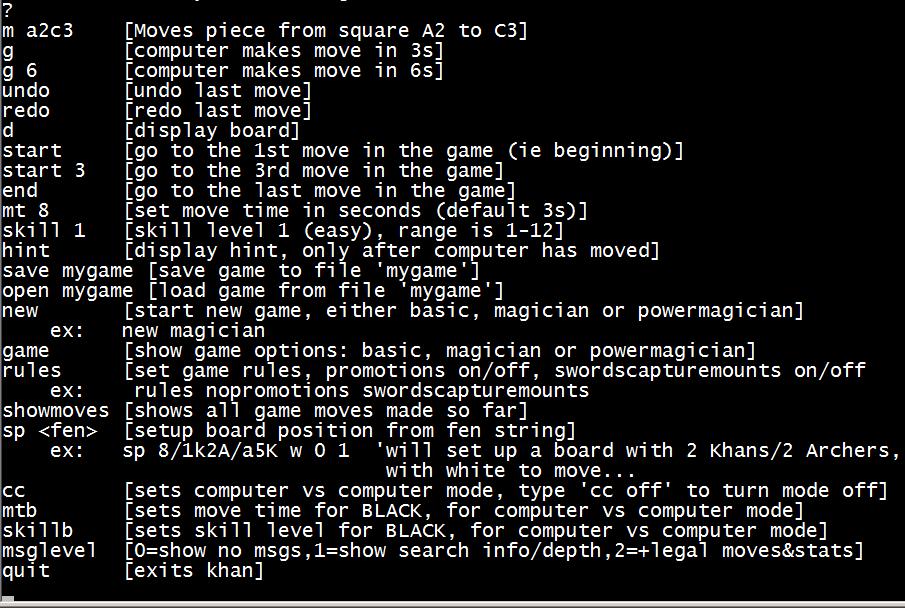
Type 'd' to display the board at any time. This is useful if the board has scrolled off the screen.
Setup a board position by entering 'sp' followed by a string that describes the piece positions & the # spaces in between the pieces and who is to move next.
For example, this string has 3 ranks populated with pieces, black and white:
sp 1k4K/6W/3w/ black 5 1
Rank 8 has 2 Khans, separated by 4 spaces (1k4K)
Rank 7 has 1 White Warrior, 6 squares to the right (6W)
Rank 6 has 1 Black Warrior, 3 squares to the right (2w)
... the other ranks are not specified (ie empty)
... black is to move
... '5' describes the # of moves since no captures
... '1' describes the move #, in this case (no moves made)
Click here for more information on fen notation
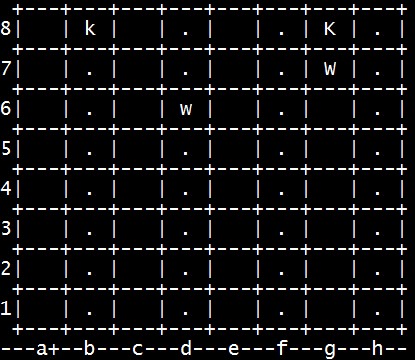
Type 'msglevel 1' or 'msglevel 2' to show the computer's statistics while searching for a move.
The default is 'msglevel 0', which suppresses output and displays only the best move.
Have fun!
Disclaimer
This program is free software and shipped with no warranties.
Redistribution
This game is currently free. You can redistribute it as is, without
modification, without monetary renumeration.
The original game design/board layout, piece movements are copyright
© 2013 Chris Turner.
The concept of Khan was inspired by ideas from Conn Iggulden's epic
saga, Wolf
of the Plains. My interest in game design over the past 20 years
has made this project possible.
Many thanks to the myriad chess programmers whose open source code and
ideas presented therein has facilited engine design, in particular,
praise for:
Winglet (Stef Luijten)
Stockfish (Tord Romstad, Marco
Costalba, Joona Kiiski)
Arasan (Jon Dart)
Crafty (Robert Hyatt)
Fruit (Fabien Letouzey)
and the gui clients:
Lantern (Michael Adams)
Jin chess (Alexander Maryanovsky)
Khan is evolving. New pieces/movements/game rules and configurations
are works in progress.
Please visit this site to download the latest versions...